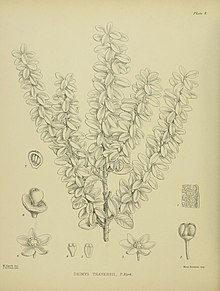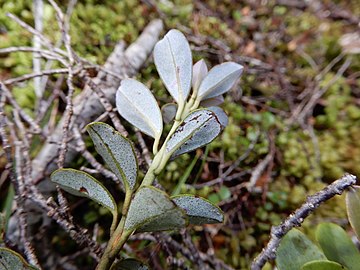| Pseudowintera traversii | |
|---|---|

| |
| Pseudowintera traversii | |

| |
| illustration of Pseudowintera traversii | |
| Conservation status | |
 Naturally Uncommon (NZ TCS) | |
| Scientific classification | |
| Kingdom: | Plantae |
| Clade: | Tracheophytes |
| Clade: | Angiosperms |
| Clade: | Magnoliids |
| Order: | Canellales |
| Family: | Winteraceae |
| Genus: | Pseudowintera |
| Species: | P. traversii |
| Binomial name | |
| Pseudowintera traversii (Buchanan) Dandy 1933 | |
| Synonyms | |
Pseudowintera traversii, sometimes called Travers horopito, is a species of woody shrub in the family Winteraceae. The specific epithet traversii is in honor of naturalist Henry H. Travers (1844–1928), son of William Thomas Locke Travers.
Description
Pseudowintera traversii is a densely branched shrub growing up to 2 metres (6 ft 7 in) high. It has coriaceous leaves that are 2–2.5 centimetres (0.79–0.98 in) long and ovate or obovate. The leaves are green-blue underneath and matte green on top, close-set and on stout petioles. The leaves may have reddish margins, but lack the picturesque blotches of P. colorata. However they are described as tasting peppery and pungent. The bark is reddish-brown and rough. The green or yellow flowers appear in January, growing singly or as doubles, or rarely triples, with 5-7 petals and 4-9 stamens. The fruit appears in February as a fleshy berry, that is purplish-black and 2–3 millimetres (0.079–0.118 in) in diameter, containing 3-6 seeds.
Like all Winteraceae species, P. traversii lacks vessels in its xylem
-
 Growth habit
Growth habit
-
 Underside of leaves
Underside of leaves
-
 A specimen from the Auckland War Memorial Museum
A specimen from the Auckland War Memorial Museum
| Ploidy | haploid |
|---|---|
| Number of chromosomes | 43 |
Habitat
Like the other species of horopito in Pseudowintera, it is endemic to New Zealand. It is the rarest of the species, and the national government there lists it as "At Risk - Naturally Uncommon." Naturally, it only is found growing in montane shrubland and woodland edges in the South Island in northwest Nelson between Westport and Collingwood. It grows from 600–1,300 metres (2,000–4,300 ft) in elevation.
Ecology
Pseudowintera traversii shares a pollinator (possibly a thrip) with P. colorata, as natural hybrids have been found where their ranges overlap. Females of the species Thrips obscuratus (New Zealand flower thrips) have been collected on P. traversii.
References
- ^ de Lange, Peter J.; Rolfe, Jeremy R.; Champion, Paul D.; Courtney, Shannel P.; Heenan, Peter B.; Barkla, John W.; Cameron, Ewen K.; Norton, David A.; Hitchmough, Rodney A. (August 2013). Conservation status of New Zealand indigenous vascular plants, 2012 (PDF). New Zealand Threat Classification Series. Vol. 3. Wellington, NZ: Publishing Team, Department of Conservation. ISBN 9780478149951. ISSN 2324-1713. Retrieved 5 February 2018.
Naturally Uncommon... Pseudowintera traversii (Buchanan) Dandy Winteraceae Data Poor
- "Pseudowintera traversii (Buchanan) Dandy". BioLib. Retrieved 1 February 2018.
- Hassler M. (2018). World Plants: Synonymic Checklists of the Vascular Plants of the World (version Dec 2017). In: Roskov Y., Abucay L., Orrell T., Nicolson D., Bailly N., Kirk P.M., Bourgoin T., DeWalt R.E., Decock W., De Wever A., Nieukerken E. van, Zarucchi J., Penev L., eds. (2018). Species 2000 & ITIS Catalogue of Life, 30th January 2018. Digital resource at http://www.catalogueoflife.org/col/details/species/id/8cfa9e142d5990e21beb50cb9e5c5724 . Species 2000: Naturalis, Leiden, the Netherlands. ISSN 2405-8858.
- ^ Gemmill, Chrissen; Clarkson, Bruce; Green, Allan; Beard, Catherine; Burns, Bruce; Holzapfel, Avi; Hicks, Brendan (1 March 2006). "Winteraceae". BIOL226C Flora of New Zealand. Hamilton, New Zealand: University of Waikato. Retrieved 6 February 2018.
Pseudowintera traversii (Travers horopito) Compactly branched shrub up to 2m tall. Leaves are 2-2.5cm long, ovate-oblong, very thick and coriaceous, dull green above, bluish-green below. Flowers solitary or in pairs. Found only in N.W. Nelson growing on montane forest margins and scrub. Foliage of Pseudowintera traversii, note that the leaves are small and the branching is quite dense
- Buchanan, John (9 December 1882). Hector, James (ed.). "Art. XLI.–Additions to the Flora of New Zealand". Transactions of the New Zealand Institute. 15: 339. OCLC 1778777. Retrieved 7 February 2018.
Hymenanthera traversii, Buchanan. A Small glabrous, branched, shrub-tree. Branches rigid, reddish-brown, rough, with viscid secretion; leaves coriaceous, alternate, olive-green, shortly petioled, ¾-1 inch long, obovate, obtuse or acute, covered closely on the back with small silvery-white tubercles, margins reflexed, venation obscure, midrib distinct, stipules very small. Flowers very small, solitary, in the axils of the upper leaves; pedicels short, curved, with small bracts at base; calyx cupular, entire; petals ⅛ inch long, linear obovate or linear oblong, obtuse. This addition to the flora of New Zealand was discovered in the bush, Collingwood district, Nelson, by Mr. H. H. Travers, while on a recent visit there. As an ornamental foliaged plant it may be commended, but from its diminutive inflorescence it can hardly claim a place in the flower border. Plate XXVIII, fig. 1, portion of branch nat. size; 1 a, flower enlarged; 1 b, petal showing glands.
- Bubelis, Walt (Winter 2013). "New Zealand Plants and their Collectors" (PDF). Washington Park Arboretum Bulletin: 24–25. ISSN 1046-8749. OCLC 487128332. Archived from the original (PDF) on 8 February 2018. Retrieved 7 February 2018.
He not only helped create the Wellington Botanic Garden but saw his passionate love of nature picked up by his son Henry (1844 -1928), who became a naturalist and professional collector. Henry Travers is responsible for the names Pseudowintera traversii, Veronica traversii, and Pimelea traversii.
- ^ Allen, H. H. 1982: Flora of New Zealand. Volume I. Volume: Indigenous Tracheophyta - Psilopsida, Lycopsida, Filicopsida, Gymnospermae, Dicotyledons. First electronic edition, Landcare Research, June 2004. Transcr. A.D. Wilton and I.M.L. Andres. https://floraseries.landcareresearch.co.nz/pages/Taxon.aspx?id=_28eba8dd-7c37-405a-98c8-c36333068505&fileName=Flora%201.xml#_28eba8dd-7c37-405a-98c8-c36333068505 . Accessed 5 February 2018.
- ^ Sampson, F. B. (1980). "Natural hybridism in Pseudowintera (Winteraceae)". New Zealand Journal of Botany. 18 (1): 43–51. doi:10.1080/0028825X.1980.10427230. ISSN 1175-8643.
- ^ Heenan, P. B.; de Lange, P. J. (2006). "Pseudowintera insperata (Winteraceae), an overlooked and rare new species from northern New Zealand". New Zealand Journal of Botany. 44 (1): 89–98. doi:10.1080/0028825X.2006.9513008. ISSN 1175-8643. S2CID 84044658.
- ^ "Pseudowintera traversii". New Zealand Plant Conservation Network. 13 January 2014. Retrieved 6 February 2018.
- Taylor S. Feild, Tim Brodribb & N. Michele Holbrook (2002). "Hardly a relict: freezing and the evolution of vesselless wood in Winteraceae" (PDF). Evolution. 56 (3): 464–478. doi:10.1554/0014-3820(2002)056[0464:HARFAT]2.0.CO;2. PMID 11989678.
- ^ Hair, J.B.; Beuzenberg, E.J. (1966). "Contributions to a chromosome atlas of the New Zealand flora —7; Miscellaneous families". New Zealand Journal of Botany. 4 (3): 255–266. doi:10.1080/0028825X.1966.10429046. ISSN 1175-8643.
- Norton, Scott A. (January 1984). "Thrips pollination in the lowland forest of New Zealand" (PDF). New Zealand Journal of Ecology. 7: 157–164. Retrieved 6 February 2018.
External links
- [REDACTED] Media related to Pseudowintera traversii at Wikimedia Commons
- [REDACTED] Data related to Pseudowintera traversii at Wikispecies
- Type specimen at Museum of New Zealand
- Drimys traversii
| Taxon identifiers | |
|---|---|
| Pseudowintera traversii |
|
| Hymenanthera traversii | |